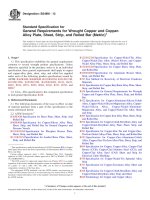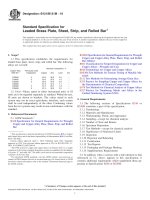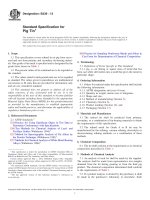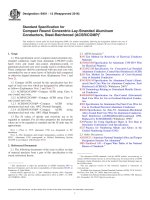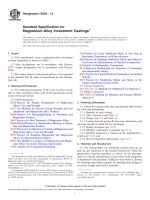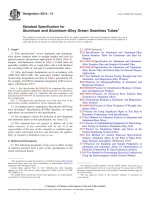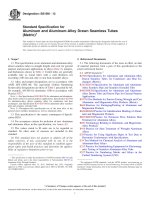Astm b 339 12
Bạn đang xem bản rút gọn của tài liệu. Xem và tải ngay bản đầy đủ của tài liệu tại đây (115.44 KB, 4 trang )
Designation: B339 − 12
Standard Specification for
Pig Tin1
This standard is issued under the fixed designation B339; the number immediately following the designation indicates the year of
original adoption or, in the case of revision, the year of last revision. A number in parentheses indicates the year of last reapproval. A
superscript epsilon (´) indicates an editorial change since the last revision or reapproval.
This standard has been approved for use by agencies of the U.S. Department of Defense.
1. Scope
E88 Practice for Sampling Nonferrous Metals and Alloys in
Cast Form for Determination of Chemical Composition
1.1 This specification covers refined tin in pig form recovered and cast from primary and secondary tin-bearing materials. One grade of tin metal is specified and is designated by the
grade letter shown in Table 1.
3. Terminology
3.1 Definitions of Terms Specific to This Standard:
3.1.1 pig, n—an oblong or square mass of metal that has
been cast while still molten into a mold that gives the metal its
particular shape.
1.2 The percent values of tin contained are to be regarded as
the standard.
1.3 The values stated in inch-pound units are to be regarded
as standard. The values given in parentheses are mathematical
conversions to SI units that are provided for information only
and are not considered standard.
1.4 This standard does not purport to address all of the
safety concerns, if any, associated with its use. It is the
responsibility of the user of this standard to become familiar
with all hazards including those identified in the appropriate
Material Safety Data Sheet (MSDS) for this product/material
as provided by the manufacturer, to establish appropriate
safety and health practices, and determine the applicability of
regulatory limitations prior to use.
4. Ordering Information
4.1 Orders for material under this specification shall include
the following information:
4.1.1 ASTM designation and year of issue,
4.1.2 Quantity in weight, metric tons or kilograms,
4.1.3 Shape and size,
4.1.4 Method of manufacturing (Section 5),
4.1.5 Chemistry (Section 6),
4.1.6 Product marking (Section 16), and
4.1.7 Packaging (Section 17).
5. Materials and Manufacture
2. Referenced Documents
5.1 The refined tin shall be produced from primary,
secondary, or a combination of tin-bearing materials to obtain
the requirements of this specification.
2.1 ASTM Standards:2
E29 Practice for Using Significant Digits in Test Data to
Determine Conformance with Specifications
E46 Test Methods for Chemical Analysis of Lead- and
Tin-Base Solder (Withdrawn 1994)3
E51 Method for Spectrographic Analysis of Tin Alloys by
the Powder Technique (Withdrawn 1983)3
E57 Methods for Chemical Analysis of White Metal Bearing
Alloys (Withdrawn 1986)3
5.2 The refined metal for Grade A or B tin may be
manufactured by fire refining, vacuum refining, electrolytic or
electrowinning refining methods, or a combination of these
methods.
6. Chemical Composition
6.1 The tin shall conform to the requirements as to chemical
composition prescribed in Table 1.
1
This specification is under the jurisdiction of ASTM Committee B02 on
Nonferrous Metals and Alloys and is the direct responsibility of Subcommittee
B02.02 on Refined Lead, Tin, Antimony, and Their Alloys.
Current edition approved May 1, 2012. Published August 2012. Originally
approved in 1967. Last previous edition approved in 2010 as B339 – 00 (2010).
DOI: 10.1520/B0339-12.
2
For referenced ASTM standards, visit the ASTM website, www.astm.org, or
contact ASTM Customer Service at For Annual Book of ASTM
Standards volume information, refer to the standard’s Document Summary page on
the ASTM website.
3
The last approved version of this historical standard is referenced on
www.astm.org.
7. Methods of Chemical Analysis
7.1 An analysis of each lot shall be made by the supplier.
The analysis shall be made from representative test samples
obtained from the lot during pouring or from the final pig
product. The chemical composition determined shall conform
to the requirements of Table 1.
7.2 If a product analysis is desired by the purchaser, it shall
be made in the purchaser’s laboratory or elsewhere. Such
Copyright © ASTM International, 100 Barr Harbor Drive, PO Box C700, West Conshohocken, PA 19428-2959. United States
1
B339 − 12
TABLE 1 Chemical Composition and Impurity Contents
Composition, - wt%
Element
Tin, min
Antimony, max
Arsenic, max
Bismuth, max
Cadmium, max
Copper, max
Iron, max
Lead, max
Ni + Co, max
Sulfur, max
Zinc, max
Silver, max
Other impuritiesA
A
Grade “A”
Grade “B”
99.85
0.04
0.05
0.030
0.001
0.04
0.010
0.05
0.01
0.01
0.005
0.01
99.85
0.015
0.05
0.030
0.001
0.04
0.010
0.5
0.01
0.01
0.005
0.01
Grade “A” for
the Manufacture
of Tinplate
Ultra Pure
Grade
99.85
0.04
0.05
0.030
0.001
0.04
0.010
0.010
0.01
0.01
0.005
0.01
0.010
99.95
0.005
0.005
0.015
0.001
0.005
0.010
0.001
0.010
0.010
0.005
0.010
0.010
Maximum per impurity not listed above.
10.3.1 If the pigs are of standard form (see Fig. 1), the
sample for chemical analysis shall be taken in accordance with
10.3.3.1, 10.3.3.2, or 10.3.3.4. If the pigs differ in shape and
size from those shown in Fig. 1, the supplier and purchaser
should agree mutually as to the method to follow in sampling
such pigs.
10.3.2 Sampling—A portion representative of the total shipment shall be selected at random for the final sample. For lots
containing at least 55 115 lb (25 000 kg) of pig tin, one pig
shall be taken for every 10 000 lb (4530 kg) or part thereof. For
smaller lots, five pigs shall be taken at random. In case of
shipment lots less than five pigs, each pig shall be sampled at
least once or as many times as may be necessary to provide a
sufficient sample for analysis. A minimum of five pigs is
preferred for sampling. If a shipment is comprised of batches
identified by heat numbers, each heat should be sampled as a
separate lot.
10.3.3 Sample Preparation—Each pig should be cleaned
thoroughly to rid the surface of dirt or adhering foreign
analysis may be made by various methods including, but not
limited to, wet chemical or spectrographic techniques.
8. Lot
8.1 All tin of Grade A or B produced and cast at one time
shall constitute a lot for chemical analysis. Each pig of the lot
shall bear a single identifying number that can be related to the
manufacturing lot. This lot number can be cast, metal die
stamped, or marked legibly upon each pig.
9. Workmanship, Finish, and Appearance
9.1 The manufacturer shall use care to have each lot of tin
material as uniform in quality as possible.
9.2 The pigs shall be clean and reasonably free of adhering
foreign material.
10. Sampling for Chemical Analysis
10.1 Care must be taken to ensure that the sample selected
for testing is representative of the material. The method of
sampling for chemical analysis shall be agreed upon mutually
between the supplier and the purchaser and shall consist of one
of the following methods:
10.1.1 Test samples taken from the lot during casting or
10.1.2 Test samples taken from the final solidified cast pig
product.
10.2 Sampling From the Lot During Casting—The supplier
may obtain representative chill cast samples from the lot of
molten metal during casting. The shape of the cast sample shall
be agreed upon by all parties concerned. The molten metal
shall be mechanically stirred and dip samples taken. If the
material is produced in a pot or kettle, the material shall be
drossed, stirred, and dip samples taken. If the facility does not
allow for dip sampling, the samples shall be taken at the
beginning, at the middle, and at the end of the pour. The
sampling ladle must be clean and heated and the molten metal
cast into chilled molds which produce forms suitable for
instrument use, drilling of cast sample, or sawing of cast
sample. Samples drawn at the producers plant shall be from a
clean bath of metal with all dross having been removed.
10.3 Sampling of Cast Pig Product:
FIG. 1 Pig Tin Sampling Methods
2
B339 − 12
material prior to sampling by one of the following methods:
sawing, drilling, or melting.
10.3.3.1 Sawing—The pigs selected shall be sawed completely through as illustrated in Fig. 1 (one cut per pig) or shall
be sawed half way across from both sides as illustrated in Fig.
2 and Fig. 3 (two cuts on each pig). The sawings from all the
pigs shall be mixed thoroughly and quartered, and the samples
for analysis taken from the mixed material. The sawings must
be free of extraneous material introduced from the saw blade.
All sawings should be screened to remove any coagulated saw
chips and treated with a strong magnet to remove iron
introduced by sawing. No lubricant shall be used when sawing.
10.3.3.2 Drilling—The pigs shall be drilled all the way
through the depth of pig as shown in Fig. 4 (one hole per pig)
or drilled half way through the depth of pig from top and
bottom as shown in Fig. 5 (two holes 1⁄2 depth per pig). A drill
size of about 1⁄2 in. (12.7 mm) in diameter is preferred and in
no instance shall the drill size be less than 3⁄8 in. (9.5 mm) in
diameter. A standing drill or bench drill should be used
whenever possible, as hand held drills are normally high speed,
therefore creating problems with drill breakage. In drilling, the
holes shall be spaced along a diagonal line from one corner of
the pig to the opposite corner. No lubricant shall be used in
drilling. The drillings shall be clipped into pieces not over 1⁄2
in. in length, mixed thoroughly, quartered, and treated with a
strong magnet to remove iron introduced by the drilling.
10.3.3.3 The saws, drills, cutter, or other tools used for
sampling shall be thoroughly cleaned prior to use. The cleaning
of the test samples shall include machining the test pieces in
several positions to remove oxidized surfaces not as specified
in Fig. 1. Metal pieces so produced are not to be included in
any sample. Whenever possible, it is preferred that the sampling tools used are not composed of material that could cause
contamination. Tools made of iron may contaminate the tin
sample if the iron particles embedded in the soft tin are not
completely removed by magnetic separation.
10.3.3.4 Melting—Whole pigs or portions of pigs produced
by sawing or drilling shall be melted under palm oil in a clean
vessel and heated to the auto ignition point (600°F (316°C)) of
palm oil, and must be stirred immediately prior to sampling.
The molten tin shall be chill cast into shapes for use in the
spectrographic analysis, or chill cast into thin sample bars not
to exceed 3⁄8 in. (9.5 mm) thick for sawing. Residual palm oil
in the surface should be removed in hot distilled water with a
suitable detergent. For sample bars, saw cuts shall be made
halfway across the bar from each side and staggered so they are
31⁄64 in. (12.5 mm) apart; the sawings so produced are treated in
accordance with 10.3.3.1.
FIG. 3 Method of Sampling Tin by Sawing
FIG. 4 Template
NOTE 1—Pigs selected for sampling shall be placed side by side, every
other pig bottom up and sampled according to template in sets of five pigs
each as indicated above. The pigs shall be drilled at least halfway through.
When a larger sample is desired the pigs shall be turned over and sampled
on the other side.
FIG. 5 Template—Method of Sampling Tin by Drilling
10.3.4 Sample Size:
10.3.4.1 For spectrographic analysis, three samples shall be
prepared of a size and shape satisfactory for use by the
laboratory at which the analysis is to be made.
10.3.4.2 For wet chemical analysis, each prepared sample
(sawings or drillings) shall weigh at least 11⁄3 lb (600 g).
10.3.5 Aspects of sampling and sample preparation not
specifically covered in this specification shall be carried out in
accordance with Practice E88.
11. Significance of Numerical Limits
11.1 For the purpose of determining compliance with the
specified limits for requirements of the properties listed in
FIG. 2 Pigs Sampled in Sets of Five According to Template as
Shown Above
3
B339 − 12
14.3 Rehearing—In the event of disagreement between the
supplier and the purchaser on the conformance of the material
to the requirements of this specification, a mutually acceptable
umpire shall perform the test in accordance with an agreed
upon method. The results of the umpire’s testing shall be used
in determining conformance of the material to this specification.
Table 1, an observed value or a calculated value shall be
rounded as indicated in accordance with the rounding method
of Practice E29.
12. Test Method
12.1 Analyze the sample of tin for impurities in accordance
with Test Methods E46 or Methods E51 or E57.
12.2 An alternative method that may be used by the purchaser is the wet chemical method; however, this method is not
acceptable in the case of disagreement.
14.4 The expenses of the umpire shall be paid by the loser
or divided in proportion to the concession made in the case of
a compromise. In case of rejection being established, the
damages shall be limited to the payment of freight both ways
by the supplier for substitution of an equivalent weight of
material conforming to this specification.
13. Inspection
13.1 Inspection may be made at the manufacturer’s factory
where the material is made, or at the point where it is received,
at the option of the purchaser.
15. Certification
15.1 When specified in the purchase order or contract, a
supplier’s certificate of analysis and weight certificate shall be
furnished to the purchaser that the material was manufactured
and inspected in accordance with this specification and has
been found to meet the requirements.
13.2 If the purchaser elects to have inspection made at the
manufacturer’s factory or at a public warehouse, the manufacturer shall afford the inspector representing the purchaser all
reasonable facilities to satisfy him that the material is being
furnished in accordance with this specification. All tests and
inspection shall be so conducted as not to interfere with the
operation of the factory.
16. Product Marking
16.1 A brand or trademark by which the supplier can be
identified shall be cast upon each pig.
14. Rejection and Rehearing
14.1 Rejection—Material that fails to conform to the requirements of this specification may be rejected. Rejection
should be reported to the supplier promptly and in writing. In
case of dissatisfaction with the results of the test, the supplier
may make claim for a rehearing.
17. Packaging and Package Marking
17.1 Unless otherwise specified, pig tin purchased under
this specification shall be stacked in a self-palletizing secure
bundle or double strapped with steel bands to ensure safe
delivery to their destination when properly transported by any
common carrier.
14.2 Rejection shall be considered as follows:
14.2.1 Variation in weight, quantity, dimensions, or quality.
14.2.2 Chemical Composition:
14.2.2.1 In case of dispute, the pigs shall be sampled in the
presence of both parties in accordance with 10.3.
14.2.2.2 The resulting sample (at least 4 lb (1800 g)) shall
be mixed and separated into three equal parts, each of which
shall be placed in a sealed package, one for the supplier, one for
the purchaser, and one for the umpire, if necessary. The
manufacturer and purchaser shall each make an analysis, and if
the results do not establish or dismiss the claim to the
satisfaction of both parties, the sample shall be submitted to a
mutually agreed upon umpire, who shall determine the question of fact, and whose determination shall be final.
18. Special Requirements
18.1 By agreement between the purchaser and the supplier,
analysis may be required and limits established for elements or
compounds not specified in Table 1.
18.2 Special sampling, marking, color coding, and other
quality requirements not covered by this specification shall be
as agreed upon between the supplier and the purchaser.
19. Keywords
19.1 chemical composition; lot; metal; pig; refined; sampling; tin
ASTM International takes no position respecting the validity of any patent rights asserted in connection with any item mentioned
in this standard. Users of this standard are expressly advised that determination of the validity of any such patent rights, and the risk
of infringement of such rights, are entirely their own responsibility.
This standard is subject to revision at any time by the responsible technical committee and must be reviewed every five years and
if not revised, either reapproved or withdrawn. Your comments are invited either for revision of this standard or for additional standards
and should be addressed to ASTM International Headquarters. Your comments will receive careful consideration at a meeting of the
responsible technical committee, which you may attend. If you feel that your comments have not received a fair hearing you should
make your views known to the ASTM Committee on Standards, at the address shown below.
This standard is copyrighted by ASTM International, 100 Barr Harbor Drive, PO Box C700, West Conshohocken, PA 19428-2959,
United States. Individual reprints (single or multiple copies) of this standard may be obtained by contacting ASTM at the above
address or at 610-832-9585 (phone), 610-832-9555 (fax), or (e-mail); or through the ASTM website
(www.astm.org). Permission rights to photocopy the standard may also be secured from the Copyright Clearance Center, 222
Rosewood Drive, Danvers, MA 01923, Tel: (978) 646-2600; />
4


